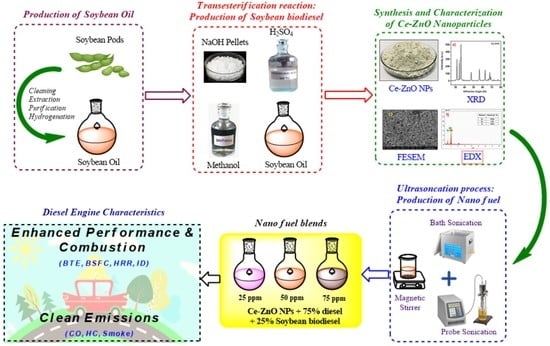Enhancement in Combustion, Performance, and Emission Characteristics of a Diesel Engine Fueled with Ce-ZnO Nanoparticle Additive Added to Soybean Biodiesel Blends
Abstract
1. Introduction
2. Materials and Methods
2.1. Production of Ce Doped ZnO Nanoparticle Additives
2.2. Uncertainty Analysis
2.3. Preparation and Physicochemical Properties of Nanoadditive Fuel Blends
3. Results and Discussion
3.1. Characterization of Nanoparticle
3.2. The Influence of Fuel Blends on Performance Characteristics
3.3. The Influence of Fuel Blends on Engine Emission Characteristics
3.3.1. CO Emission
3.3.2. NOx Emission
3.3.3. Smoke Emission
3.3.4. Hydrocarbon Emission
3.4. Influence on Engine Combustion Characteristics
3.4.1. Heat Release Rate
3.4.2. Ignition Delay
4. Conclusions
- The physicochemical properties, for instance the calorific value and CN increase, and cold flow properties were enhanced by including Ce-ZnO nanoparticles in SBME25 fuel. In addition, the viscosity and density of all the nano fuel blend slightly reduced due to the addition of a 2% span80 surfactant compared to SBME25.
- The laboratory synthesis of Ce-coated ZnO nanoparticles and soybean biodiesel considerably reduced the procurement cost of commercially available biodiesel and nanoparticles.
- The ultrasonication process and addition of span80 enabled steady dispersal of Ce-ZnO nanoparticles in the biodiesel fuel blends.
- The fuel blend SBME25Ce-ZnO50 illustrated a comprehensive enhancement in engine characteristics. At CR 19.5, Ce-ZnO nanoparticles in SBME25 enhanced the performance characteristics; 50 ppm of Ce-ZnO in SBME25 improved BTE by 20.6% and lowered the specific fuel consumption by 21.8% in comparison with SBME25 fuel blend.
- The ternary fuel blends illustrated lower emissions; for SBME25Ce-ZnO50, the CO, HC, and smoke reduced by 30%, 21.5%, and 18.7% compared to SBME25 fuel blends, respectively, because of improved microexplosion and oxygen content, resulting in complete fuel combustion.
- The combustion characteristics improved with the addition of Ce-ZnO in the SBME25 fuel blend: the HRR enhanced by 18.1% and the ID reduced by 11.2%.
- SBME25Ce-ZnO50 showed best results for most criteria compared to other blends as well as SBME25 fuel operation.
- The combustion, performance, and emission characteristics of SBME25Ce-ZnO50 operation were slightly worse than those of diesel operation.
Author Contributions
Funding
Acknowledgments
Conflicts of Interest
Nomenclature
| NPs | Nanoparticles | ZnO | Zinc oxide |
| VCR | Variable compression ratio | Ce | Cerium |
| CI | Compression ignition | Span80 | Sorbitan oleate |
| nm | Nanometer | IC | Internal combustion |
| g/kWh | Grams per kilowatt hour | ppm | Parts per million |
| CC | Combustion chamber | m | Meter |
| ATDC | After top dead center | HCC | Hemispherical combustion chamber |
| FFA | Free fatty acid | BTDC | Before top dead center |
| ASTM | American Society for Testing and Materials | CR | Compression ratio |
| ID | Injection delay | PP | Peak pressure |
| CO2 | Carbon dioxide | HC | Hydrocarbon |
| NOX | Oxides of nitrogen | CO | Carbon monoxide |
| BTE | Brake thermal efficiency | PM | Particulate matter |
| IP | Injection pressure | BSFC | Brake specific fuel consumption |
| IT | Injection timing | Tw | Wall temperature |
| HRR | Heat release rate | °CA | Crank angle (degrees) |
| D100 | 100% diesel | SBME | Soybean methyl ester (Soybean biodiesel) |
| SBME25 | 25% Soybean methyl ester blended with diesel | SBME25 Ce-ZnO25 | SBME25 and 25 ppm Ce-ZnO NPs |
| SBME25 Ce-ZnO50 | SBME25 and 50 ppm Ce-ZnO NPs | SBME25 Ce-ZnO75 | SBME25 and 75 ppm Ce-ZnO NPs |
References
- Ashrafur Rahman, S.M.; Rainey, T.J.; Ristovski, Z.D.; Dowell, A.; Islam, M.A.; Nabi, M.N.; Brown, R.J. Review on the Use of Essential Oils in Compression Ignition Engines. In Methanol and the Alternate Fuel Economy; Agarwal, A.K., Gautam, A., Sharma, N., Singh, A.P., Eds.; Springer Singapore: Singapore, 2019; pp. 157–182. [Google Scholar] [CrossRef]
- Rahman, S.A.; Hossain, F.; Van, T.C.; Dowell, A.; Islam, M.; Rainey, T.J.; Ristovski, Z.D.; Brown, R. Comparative evaluation of the effect of sweet orange oil-diesel blend on performance and emissions of a multi-cylinder compression ignition engine. In Proceedings of the 7th Bsme International Conference on Thermal Engineering; AIP Publishing: New York, NY, USA, 2017; Volume 1851, p. 20007. [Google Scholar] [CrossRef]
- Rahman, S.M.A.; Mahila, T.M.I.; Ahmad, A.; Nabi, M.N.; Jafari, M.; Dowell, A.; Islam, M.A.; Marchese, A.J.; Tryner, J.; Brooks, P.R.; et al. Effect of Oxygenated Functional Groups in Essential Oils on Diesel Engine Performance, Emissions, and Combustion Characteristics. Energy Fuels 2019, 33, 9828–9834. [Google Scholar] [CrossRef]
- Soudagar, M.E.M.; Nik-Ghazali, N.-N.; Kalam, M.A.; Badruddin, I.; Banapurmath, N.; Akram, N. The effect of nano-additives in diesel-biodiesel fuel blends: A comprehensive review on stability, engine performance and emission characteristics. Energy Convers. Manag. 2018, 178, 146–177. [Google Scholar] [CrossRef]
- Mahlia, T.M.I.; Syazmi, Z.A.H.S.; Mofijur, M.; Abas, A.E.P.; Bilad, M.R.; Ong, H.C.; Silitonga, A.S. Patent landscape review on biodiesel production: Technology updates. Renew. Sustain. Energy Rev. 2020, 118, 109526. [Google Scholar] [CrossRef]
- Harari, P.; Banapurmath, N.; Yaliwal, V.; Khan, T.Y.; Soudagar, M.E.M. Experimental studies on performance and emission characteristics of reactivity controlled compression ignition (RCCI) engine operated with gasoline and Thevetia Peruviana biodiesel. Renew. Energy 2020, 160, 865–875. [Google Scholar] [CrossRef]
- Soudagar, M.E.M.; Afzal, A.; Kareemullah, M. Waste coconut oil methyl ester with and without additives as an alternative fuel in diesel engine at two different injection pressures. Energy Sources Part A Recovery Utilization Environ. Effects 2020, 1–19. [Google Scholar] [CrossRef]
- Mujtaba, M.; Masjuki, H.; Kalam, M.; Ong, H.C.; Gul, M.; Farooq, M.; Soudagar, M.E.M.; Ahmed, W.; Harith, M.; Yusoff, M. Ultrasound-assisted process optimization and tribological characteristics of biodiesel from palm-sesame oil via response surface methodology and extreme learning machine-Cuckoo search. Renew. Energy 2020, 158, 202–214. [Google Scholar] [CrossRef]
- Mujtaba, M.; Masjuki, H.H.; Kalam, M.; Noor, F.; Farooq, M.; Ong, H.C.; Gul, M.; Soudagar, M.E.M.; Bashir, S.; Fattah, I.M.R.; et al. Effect of Additivized Biodiesel Blends on Diesel Engine Performance, Emission, Tribological Characteristics, and Lubricant Tribology. Energies 2020, 13, 3375. [Google Scholar] [CrossRef]
- Silitonga, A.; Masjuki, H.; Mahlia, T.; Ong, H.; Chong, W.; Boosroh, M. Overview properties of biodiesel diesel blends from edible and non-edible feedstock. Renew. Sustain. Energy Rev. 2013, 22, 346–360. [Google Scholar] [CrossRef]
- Fattah, I.M.R.; Masjuki, H.H.; Kalam, M.A.; Hazrat, M.A.; Masum, B.M.; Imtenan, S.; Ashraful, A.M. Effect of antioxidants on oxidation stability of biodiesel derived from vegetable and animal based feedstocks. Renew. Sustain. Energy Rev. 2014, 30, 356–370. [Google Scholar] [CrossRef]
- Ashraful, A.M.; Masjuki, H.H.; Kalam, M.A.; Rizwanul Fattah, I.M.; Imtenan, S.; Shahir, S.A.; Mobarak, H.M. Production and comparison of fuel properties, engine performance, and emission characteristics of biodiesel from various non-edible vegetable oils: A review. Energy Convers. Manag. 2014, 80, 202–228. [Google Scholar] [CrossRef]
- Farade, R.A.; Abdul Wahab, N.I.; Mansour, D.-E.A.; Azis, N.B.; Soudagar, M.E.M.; Siddappa, V. Development of Graphene Oxide-Based Nonedible Cottonseed Nanofluids for Power Transformers. Materials 2020, 13, 2569. [Google Scholar] [CrossRef] [PubMed]
- Silitonga, A.; Shamsuddin, A.; Mahlia, T.; Milano, J.; Kusumo, F.; Siswantoro, J.; Dharma, S.; Sebayang, A.; Masjuki, H.; Ong, H.C. Biodiesel synthesis from Ceiba pentandra oil by microwave irradiation-assisted transesterification: ELM modeling and optimization. Renew. Energy 2020, 146, 1278–1291. [Google Scholar] [CrossRef]
- Ong, H.C.; Milano, J.; Silitonga, A.S.; Hassan, M.H.; Shamsuddin, A.H.; Wang, C.T.; Mahlia, T.M.I.; Siswantoro, J.; Kusumo, F.; Sutrisno, J. Biodiesel production from Calophyllum inophyllum-Ceiba pentandra oil mixture: Optimization and characterization. J. Clean. Prod. 2019, 219, 183–198. [Google Scholar] [CrossRef]
- Fattah, I.M.R.; Masjuki, H.H.; Liaquat, A.M.; Ramli, R.; Kalam, M.A.; Riazuddin, V.N. Impact of various biodiesel fuels obtained from edible and non-edible oils on engine exhaust gas and noise emissions. Renew. Sustain. Energy Rev. 2013, 18, 552–567. [Google Scholar] [CrossRef]
- Liaquat, A.M.; Masjuki, H.H.; Kalam, M.A.; Rizwanul Fattah, I.M. Impact of biodiesel blend on injector deposit formation. Energy 2014, 72, 813–823. [Google Scholar] [CrossRef]
- Khan, H.; Soudagar, M.E.M.; Kumar, R.H.; Safaei, M.R.; Farooq, M.; Khidmatgar, A.; Banapurmath, N.R.; Farade, R.A.; Abbas, M.M.; Afzal, A. Effect of Nano-Graphene Oxide and n-Butanol Fuel Additives Blended with Diesel—Nigella sativa Biodiesel Fuel Emulsion on Diesel Engine Characteristics. Symmetry 2020, 12, 961. [Google Scholar] [CrossRef]
- Imtenan, S.; Varman, M.; Masjuki, H.H.; Kalam, M.A.; Sajjad, H.; Arbab, M.I.; Fattah, I.M.R. Impact of low temperature combustion attaining strategies on diesel engine emissions for diesel and biodiesels: A review. Energy Convers. Manag. 2014, 80, 329–356. [Google Scholar] [CrossRef]
- Imtenan, S.; Masjuki, H.H.; Varman, M.; Rizwanul Fattah, I.M. Evaluation of n-butanol as an oxygenated additive to improve combustion-emission-performance characteristics of a diesel engine fuelled with a diesel-calophyllum inophyllum biodiesel blend. RSC Adv. 2015, 5, 17160–17170. [Google Scholar] [CrossRef]
- Farade, R.A.; Wahab, N.I.B.A.; Mansour, D.-E.A.; Azis, N.B.; Jasni, J.; Banapurmath, N.; Soudagar, M.E.M. Investigation of the dielectric and thermal properties of non-edible cottonseed oil by infusing h-BN nanoparticles. IEEE Access 2020, 8, 76204–76217. [Google Scholar] [CrossRef]
- S Gavhane, R.; M Kate, A.; Pawar, A.; Safaei, M.R.; M Soudagar, M.E.; Mujtaba Abbas, M.; Muhammad Ali, H.; R Banapurmath, N.; Goodarzi, M.; Badruddin, I.A. Effect of Zinc Oxide Nano-Additives and Soybean Biodiesel at Varying Loads and Compression Ratios on VCR Diesel Engine Characteristics. Symmetry 2020, 12, 1042. [Google Scholar] [CrossRef]
- Soudagar, M.E.M.; Nik-Ghazali, N.-N.; Akram, N.; Al-Rashid, M.A.; Badruddin, I.A.; Khan, H.; Kallannavar, V.; Shahpurkar, K.; Afzal, A.; Farade, R.; et al. The potential of nanoparticle additives in biodiesel: A fundamental outset. In Proceedings of the Advances in Mechanical Design, Materials and Manufacture; AIP Publishing LLC: New York, NY, USA, 2020; p. 030003. [Google Scholar] [CrossRef]
- Mujtaba, M.; Kalam, M.; Masjuki, H.; Gul, M.; Soudagar, M.E.M.; Ong, H.C.; Ahmed, W.; Atabani, A.; Razzaq, L.; Yusoff, M. Comparative study of nanoparticles and alcoholic fuel additives-biodiesel-diesel blend for performance and emission improvements. Fuel 2020, 279, 118434. [Google Scholar] [CrossRef]
- Heidari-Maleni, A.; Gundoshmian, T.M.; Karimi, B.; Jahanbakhshi, A.; Ghobadian, B. A novel fuel based on biocompatible nanoparticles and ethanol-biodiesel blends to improve diesel engines performance and reduce exhaust emissions. Fuel 2020, 276, 118079. [Google Scholar] [CrossRef]
- El-Seesy, A.I.; Hassan, H.; Ibraheem, L.; He, Z.; Soudagar, M.E.M. Combustion, emission, and phase stability features of a diesel engine fueled by Jatropha/ethanol blends and n-butanol as co-solvent. Int. J. Green Energy 2020, 1–12. [Google Scholar] [CrossRef]
- Akram, N.; Sadri, R.; Kazi, S.; Zubir, M.N.M.; Ridha, M.; Ahmed, W.; Soudagar, M.E.M.; Arzpeyma, M. A comprehensive review on nanofluid operated solar flat plate collectors. J. Therm. Anal. Calorim. 2020, 139, 1309–1343. [Google Scholar] [CrossRef]
- Akram, N.; Sadri, R.; Kazi, S.; Ahmed, S.; Zubir, M.; Ridha, M.; Soudagar, M.; Ahmed, W.; Arzpeyma, M.; Tong, G.B. An experimental investigation on the performance of a flat-plate solar collector using eco-friendly treated graphene nanoplatelets–water nanofluids. J. Therm. Anal. Calorim. 2019, 138, 609–621. [Google Scholar] [CrossRef]
- Fangsuwannarak, K.; Triratanasirichai, K. Improvements of palm biodiesel properties by using nano-TiO2 additive, exhaust emission and engine performance. Rom. Rev. Precis. Mech. Opt. Mechatron 2013, 43, 111–118. [Google Scholar]
- Jung, H.; Kittelson, D.B.; Zachariah, M.R. The influence of a cerium additive on ultrafine diesel particle emissions and kinetics of oxidation. Combust. Flame 2005, 142, 276–288. [Google Scholar] [CrossRef]
- Kumar, S.; Dinesha, P.; Rosen, M.A. Effect of injection pressure on the combustion, performance and emission characteristics of a biodiesel engine with cerium oxide nanoparticle additive. Energy 2019, 185, 1163–1173. [Google Scholar] [CrossRef]
- Sivakumar, M.; Shanmuga Sundaram, N.; Ramesh kumar, R.; Syed Thasthagir, M.H. Effect of aluminium oxide nanoparticles blended pongamia methyl ester on performance, combustion and emission characteristics of diesel engine. Renew. Energy 2018, 116, 518–526. [Google Scholar] [CrossRef]
- Sajith, V.; Sobhan, C.; Peterson, G. Experimental investigations on the effects of cerium oxide nanoparticle fuel additives on biodiesel. Adv. Mech. Eng. 2010, 2, 581407. [Google Scholar] [CrossRef]
- Alagumalai, A. Combustion characteristics of lemongrass (Cymbopogon flexuosus) oil in a partial premixed charge compression ignition engine. Alex. Eng. J. 2015, 54, 405–413. [Google Scholar] [CrossRef]
- Basha, J.S.; Anand, R. Performance, emission and combustion characteristics of a diesel engine using Carbon Nanotubes blended Jatropha Methyl Ester Emulsions. Alex. Eng. J. 2014, 53, 259–273. [Google Scholar] [CrossRef]
- Fattah, I.M.R.; Masjuki, H.H.; Kalam, M.A.; Wakil, M.A.; Ashraful, A.M.; Shahir, S.A. Experimental investigation of performance and regulated emissions of a diesel engine with Calophyllum inophyllum biodiesel blends accompanied by oxidation inhibitors. Energy Convers. Manag. 2014, 83, 232–240. [Google Scholar] [CrossRef]
- Fattah, I.M.R.; Masjuki, H.H.; Kalam, M.A.; Mofijur, M.; Abedin, M.J. Effect of antioxidant on the performance and emission characteristics of a diesel engine fueled with palm biodiesel blends. Energy Convers. Manag. 2014, 79, 265–272. [Google Scholar] [CrossRef]
- Fattah, I.M.R.; Masjuki, H.H.; Kalam, M.A.; Wakil, M.A.; Rashedul, H.K.; Abedin, M.J. Performance and emission characteristics of a CI engine fueled with Cocos nucifera and Jatropha curcas B20 blends accompanying antioxidants. Ind. Crops Products 2014, 57, 132–140. [Google Scholar] [CrossRef]
- Moffat, R.J. Describing the uncertainties in experimental results. Exp. Therm. Fluid Sci. 1988, 1, 3–17. [Google Scholar] [CrossRef]
- Soudagar, M.E.M.; Nik-Ghazali, N.-N.; Kalam, M.; Badruddin, I.A.; Banapurmath, N.; Ali, M.A.B.; Kamangar, S.; Cho, H.M.; Akram, N. An investigation on the influence of aluminium oxide nano-additive and honge oil methyl ester on engine performance, combustion and emission characteristics. Renew. Energy 2020, 146, 2291–2307. [Google Scholar] [CrossRef]
- Soudagar, M.E.M.; Nik-Ghazali, N.-N.; Kalam, M.; Badruddin, I.A.; Banapurmath, N.; Khan, T.Y.; Bashir, M.N.; Akram, N.; Farade, R.; Afzal, A. The effects of graphene oxide nanoparticle additive stably dispersed in dairy scum oil biodiesel-diesel fuel blend on CI engine: Performance, emission and combustion characteristics. Fuel 2019, 257, 116015. [Google Scholar] [CrossRef]
- Naveed Ul Haq, A.; Nadhman, A.; Ullah, I.; Mustafa, G.; Yasinzai, M.; Khan, I. Synthesis approaches of zinc oxide nanoparticles: The dilemma of ecotoxicity. J. Nanomater. 2017, 2017, 8510342. [Google Scholar] [CrossRef]
- Hasnidawani, J.; Azlina, H.; Norita, H.; Bonnia, N.; Ratim, S.; Ali, E. Synthesis of ZnO nanostructures using sol-gel method. Procedia Chem. 2016, 19, 211–216. [Google Scholar] [CrossRef]
- Sadhik Basha, J.; Anand, R. Role of nanoadditive blended biodiesel emulsion fuel on the working characteristics of a diesel engine. J. Renew. Sustain. Energy 2011, 3, 023106. [Google Scholar] [CrossRef]
- Khalife, E.; Tabatabaei, M.; Demirbas, A.; Aghbashlo, M. Impacts of additives on performance and emission characteristics of diesel engines during steady state operation. Prog. Energy Combust. Sci. 2017, 59, 32–78. [Google Scholar] [CrossRef]
- Annamalai, M.; Dhinesh, B.; Nanthagopal, K.; Sivarama Krishnan, P.; Lalvani, J.I.J.; Parthasarathy, M.; Annamalai, K. An assessment on performance, combustion and emission behavior of a diesel engine powered by ceria nanoparticle blended emulsified biofuel. Energy Convers. Manag. 2016, 123, 372–380. [Google Scholar] [CrossRef]
- Ashok, B.; Nanthagopal, K.; Mohan, A.; Johny, A.; Tamilarasu, A. Comparative analysis on the effect of zinc oxide and ethanox as additives with biodiesel in CI engine. Energy 2017, 140, 352–364. [Google Scholar] [CrossRef]
- EPA. Latest Findings on National Air Quality: Status and Trends through 2006; U.S. Environmental Protection Agency: Durham, NC, USA, 2008. [Google Scholar]
- Örs, I.; Sarıkoç, S.; Atabani, A.E.; Ünalan, S.; Akansu, S.O. The effects on performance, combustion and emission characteristics of DICI engine fuelled with TiO2 nanoparticles addition in diesel/biodiesel/n-butanol blends. Fuel 2018, 234, 177–188. [Google Scholar] [CrossRef]
- Saxena, V.; Kumar, N.; Saxena, V.K. Multi-objective optimization of modified nanofluid fuel blends at different TiO2 nanoparticle concentration in diesel engine: Experimental assessment and modeling. Appl. Energy 2019, 248, 330–353. [Google Scholar] [CrossRef]
- Palash, S.M.; Kalam, M.A.; Masjuki, H.H.; Masum, B.M.; Rizwanul Fattah, I.M.; Mofijur, M. Impacts of biodiesel combustion on NOx emissions and their reduction approaches. Renew. Sustain. Energy Rev. 2013, 23, 473–490. [Google Scholar] [CrossRef]
- Raju, V.D.; Kishore, P.; Nanthagopal, K.; Ashok, B. An experimental study on the effect of nanoparticles with novel tamarind seed methyl ester for diesel engine applications. Energy Convers. Manag. 2018, 164, 655–666. [Google Scholar] [CrossRef]
- Venu, H.; Raju, V.D.; Subramani, L. Combined effect of influence of nano additives, combustion chamber geometry and injection timing in a DI diesel engine fuelled with ternary (diesel-biodiesel-ethanol) blends. Energy 2019, 174, 386–406. [Google Scholar] [CrossRef]
- Fattah, I.M.R.; Ming, C.; Chan, Q.N.; Wehrfritz, A.; Pham, P.X.; Yang, W.; Kook, S.; Medwell, P.R.; Yeoh, G.H.; Hawkes, E.R.; et al. Spray and Combustion Investigation of Post Injections under Low-Temperature Combustion Conditions with Biodiesel. Energy Fuels 2018, 32, 8727–8742. [Google Scholar] [CrossRef]
- Karthikeyan, S.; Elango, A.; Prathima, A. Performance and emission study on zinc oxide nano particles addition with pomolion stearin wax biodiesel of CI engine. J. Sci. Ind. Res. 2014, 73, 187–190. [Google Scholar]
- Prabu, A. Nanoparticles as additive in biodiesel on the working characteristics of a DI diesel engine. Ain Shams Eng. J. 2018, 9, 2343–2349. [Google Scholar] [CrossRef]


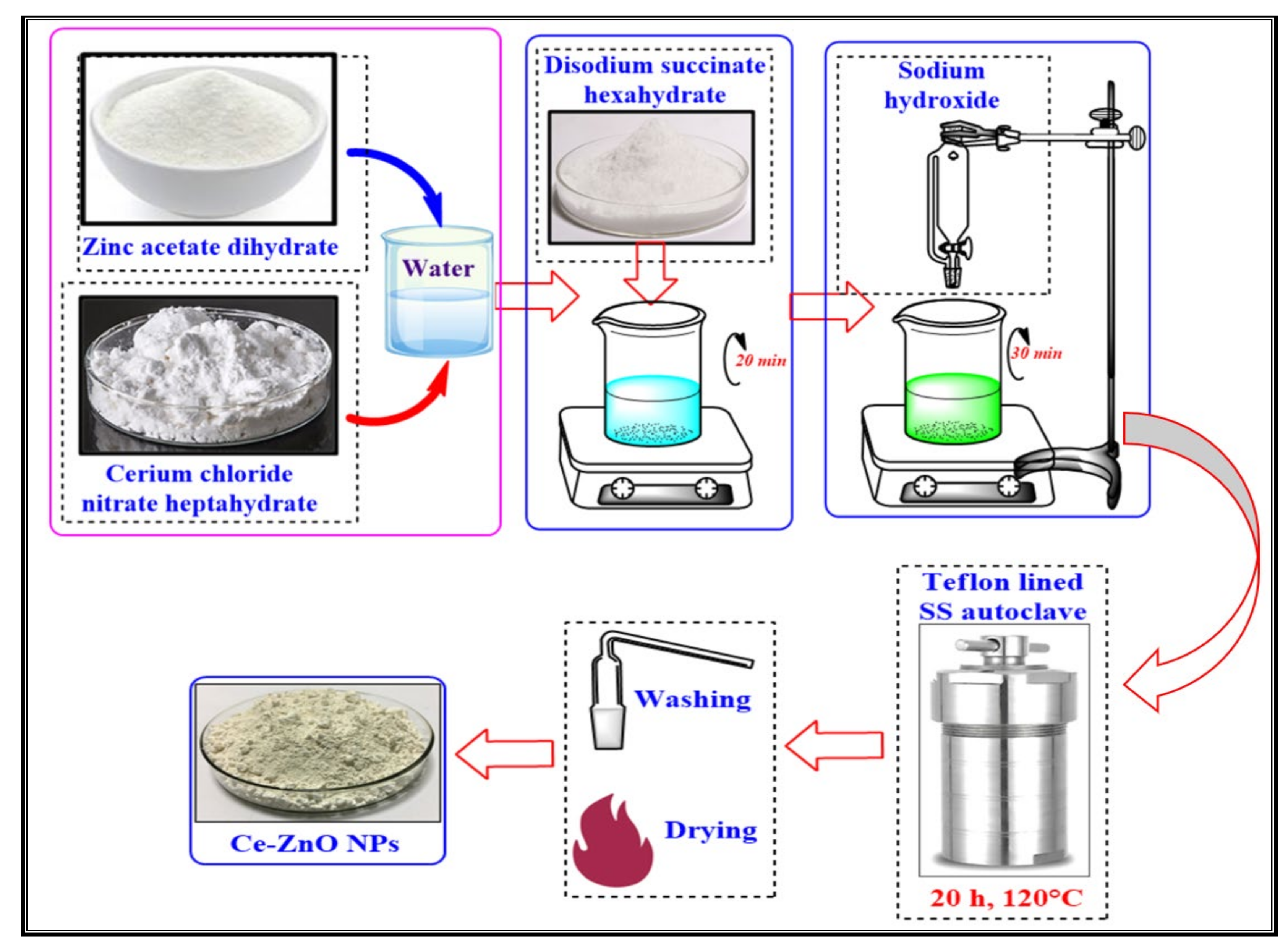

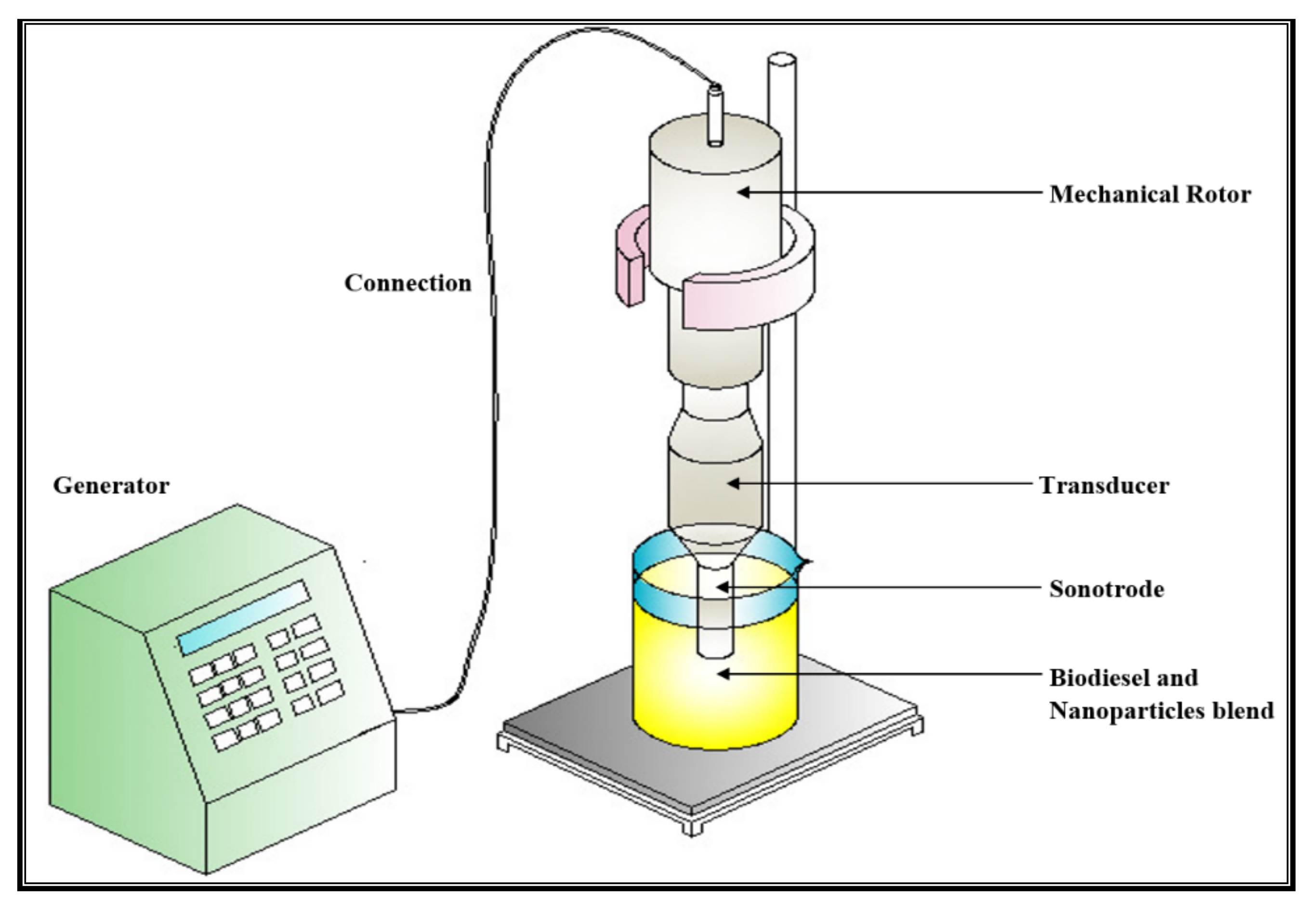
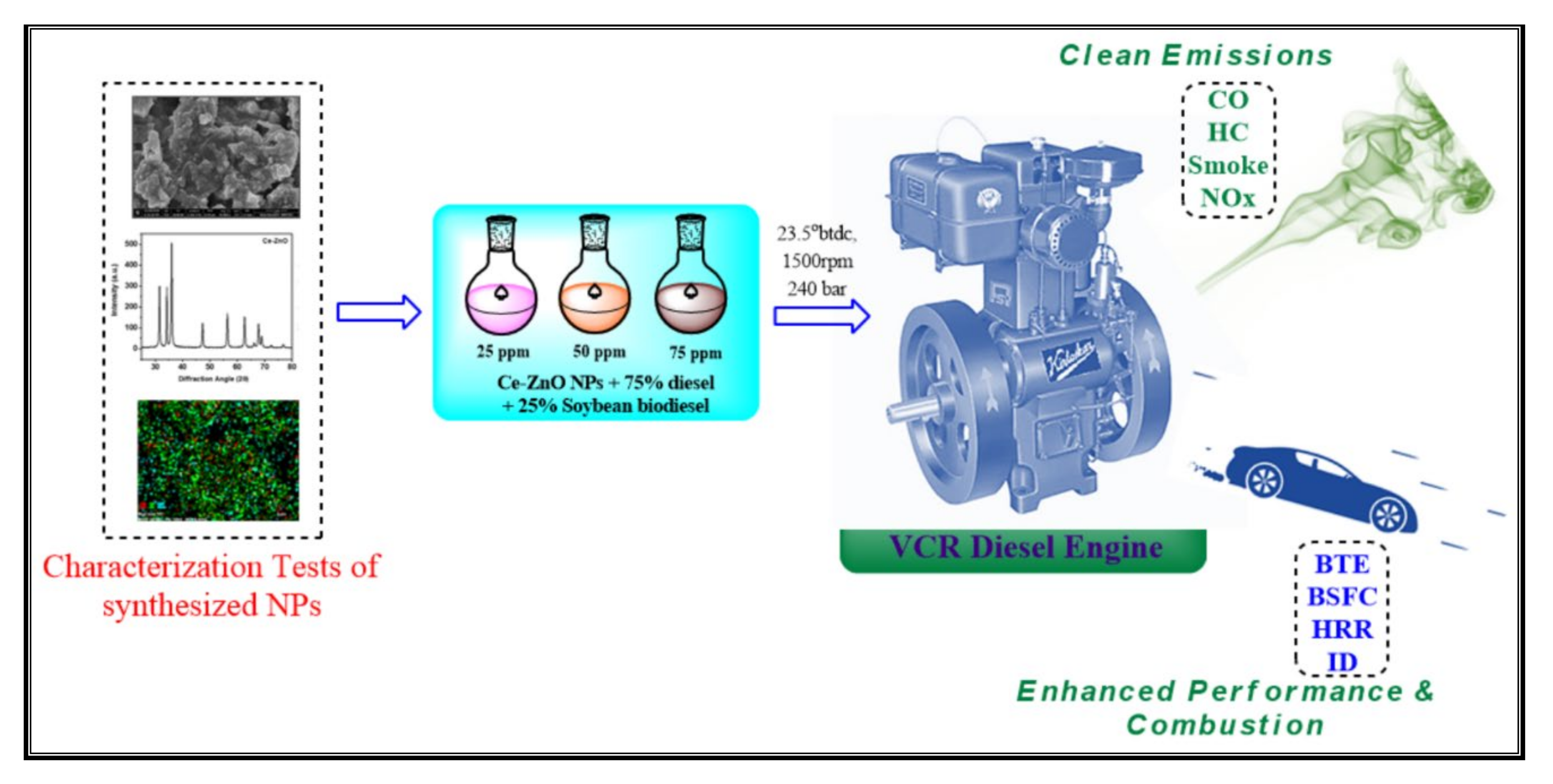

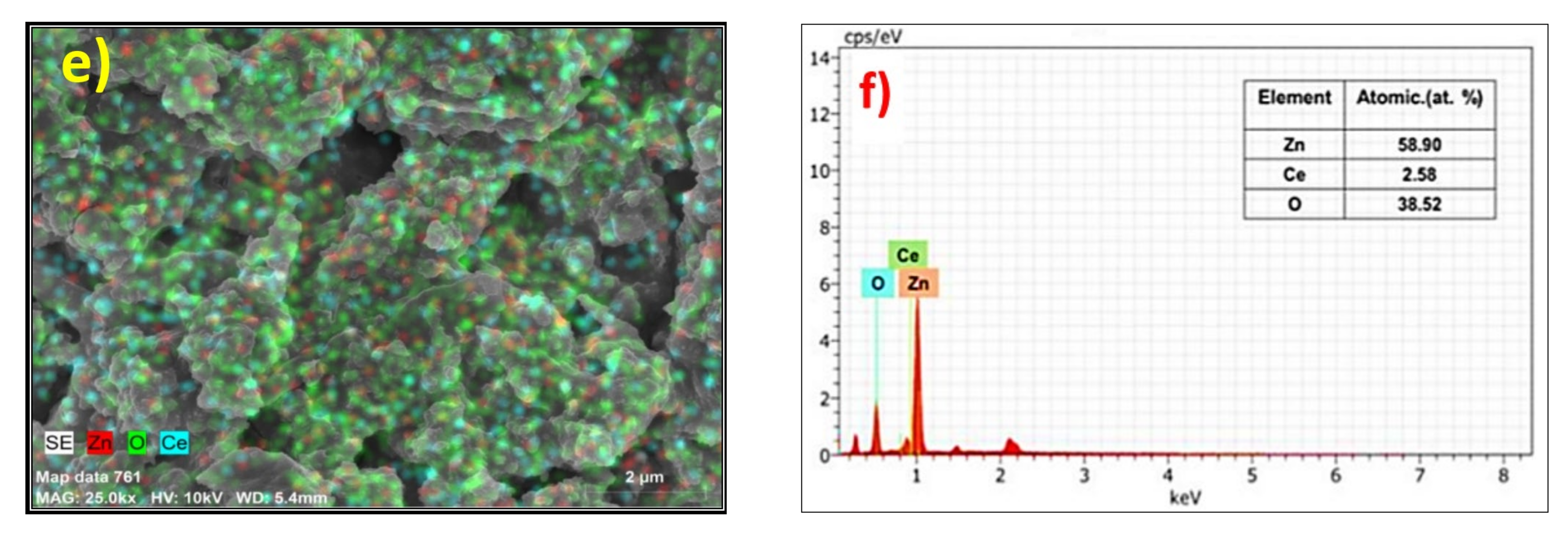
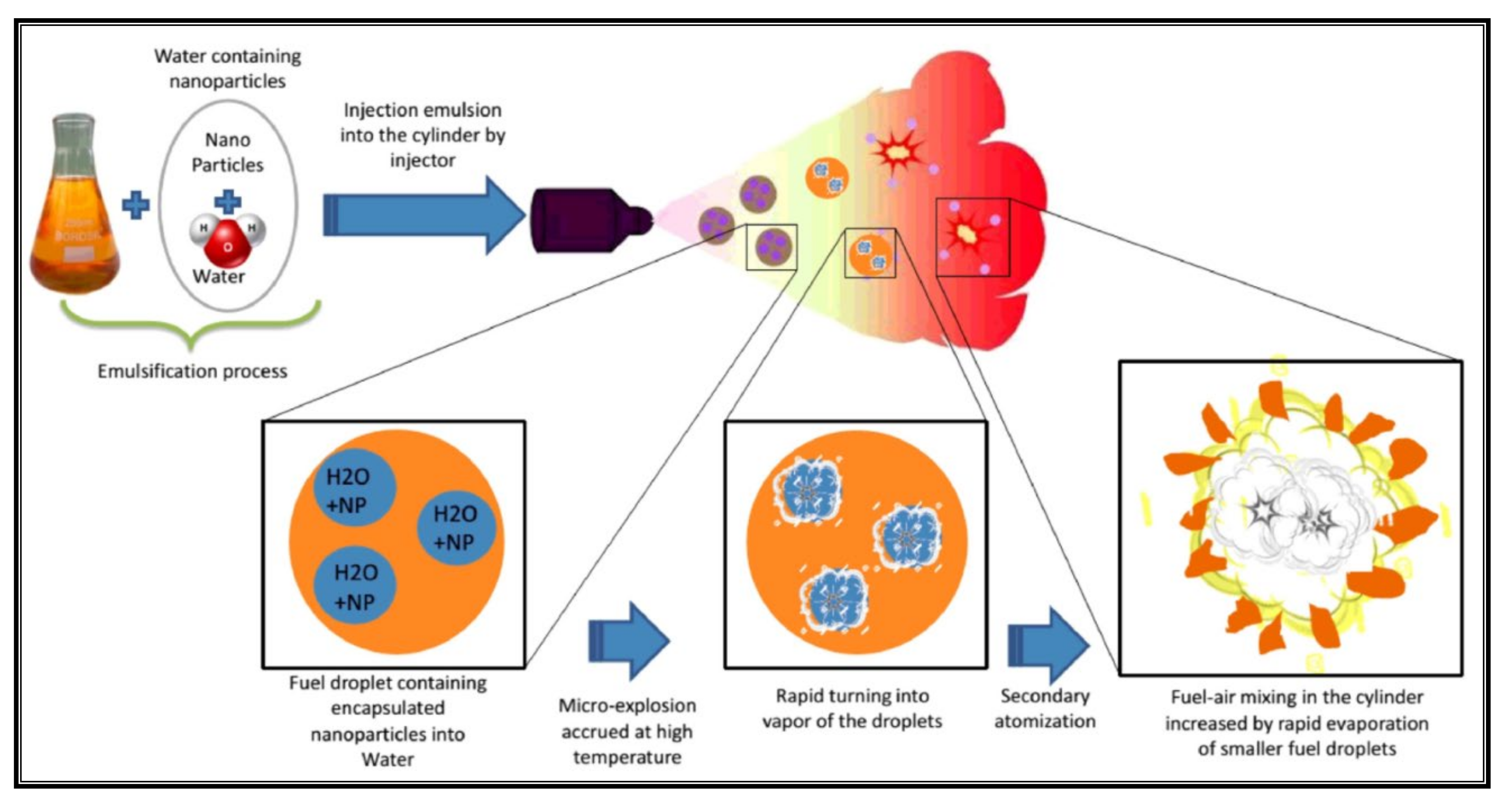



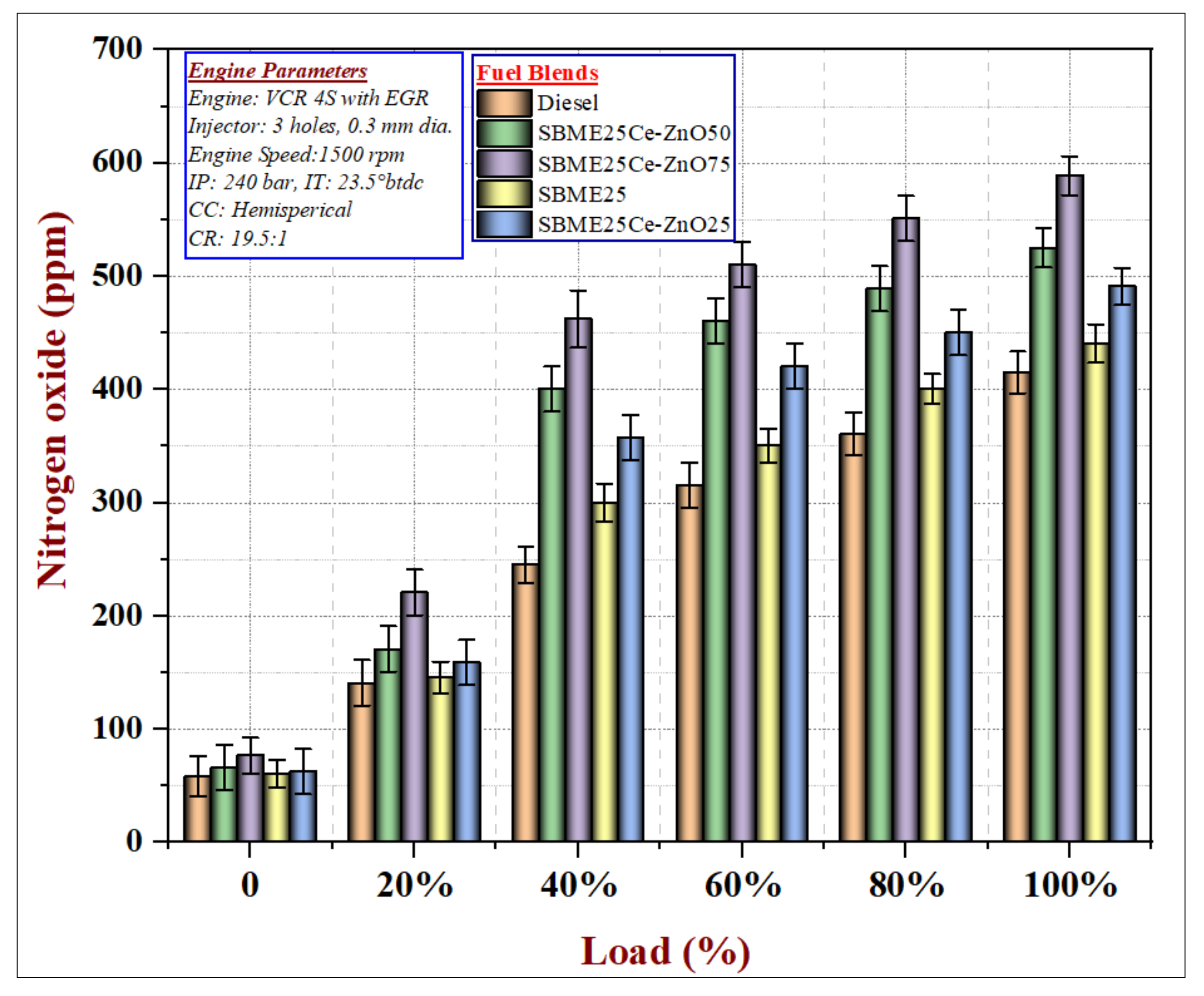
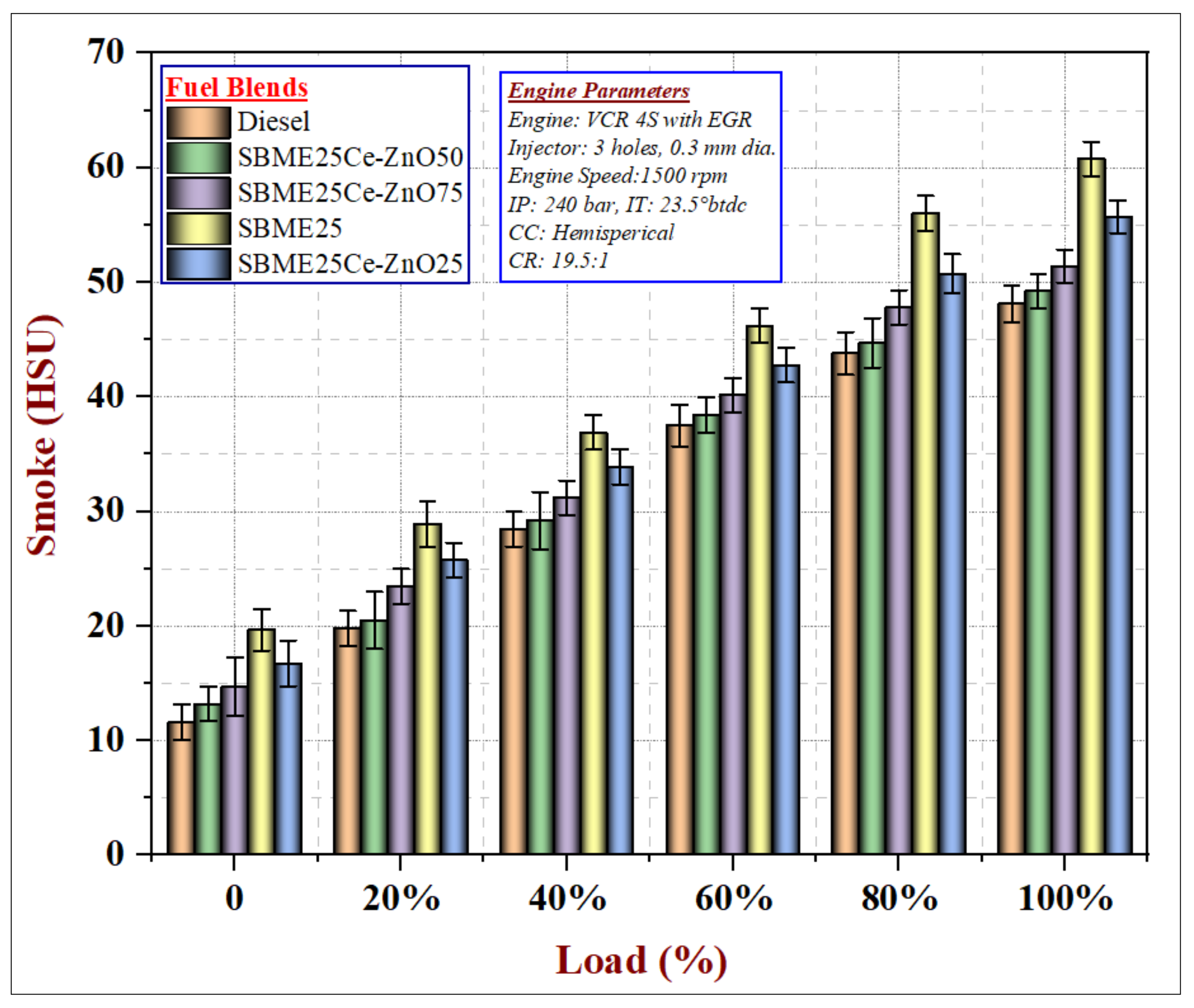
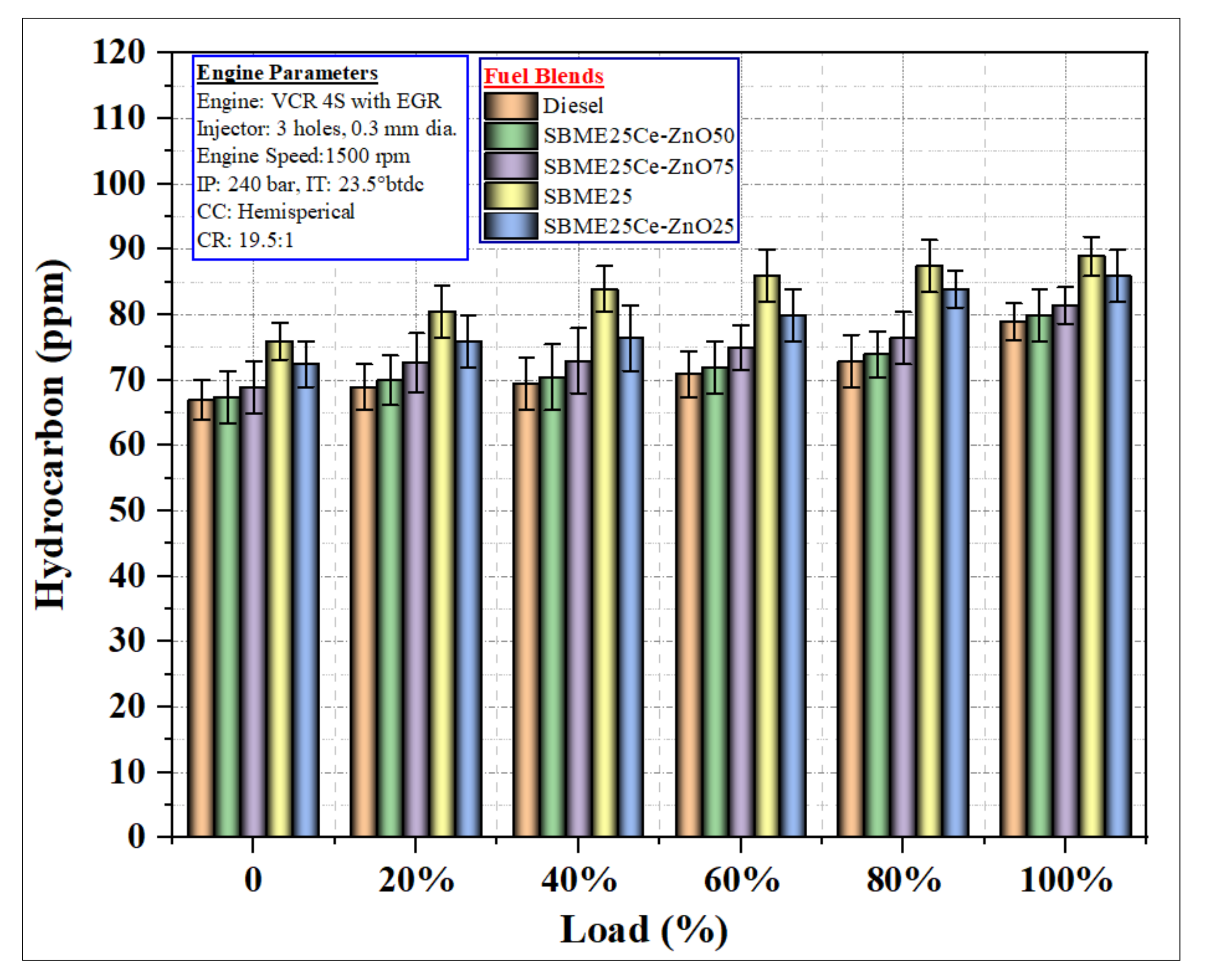
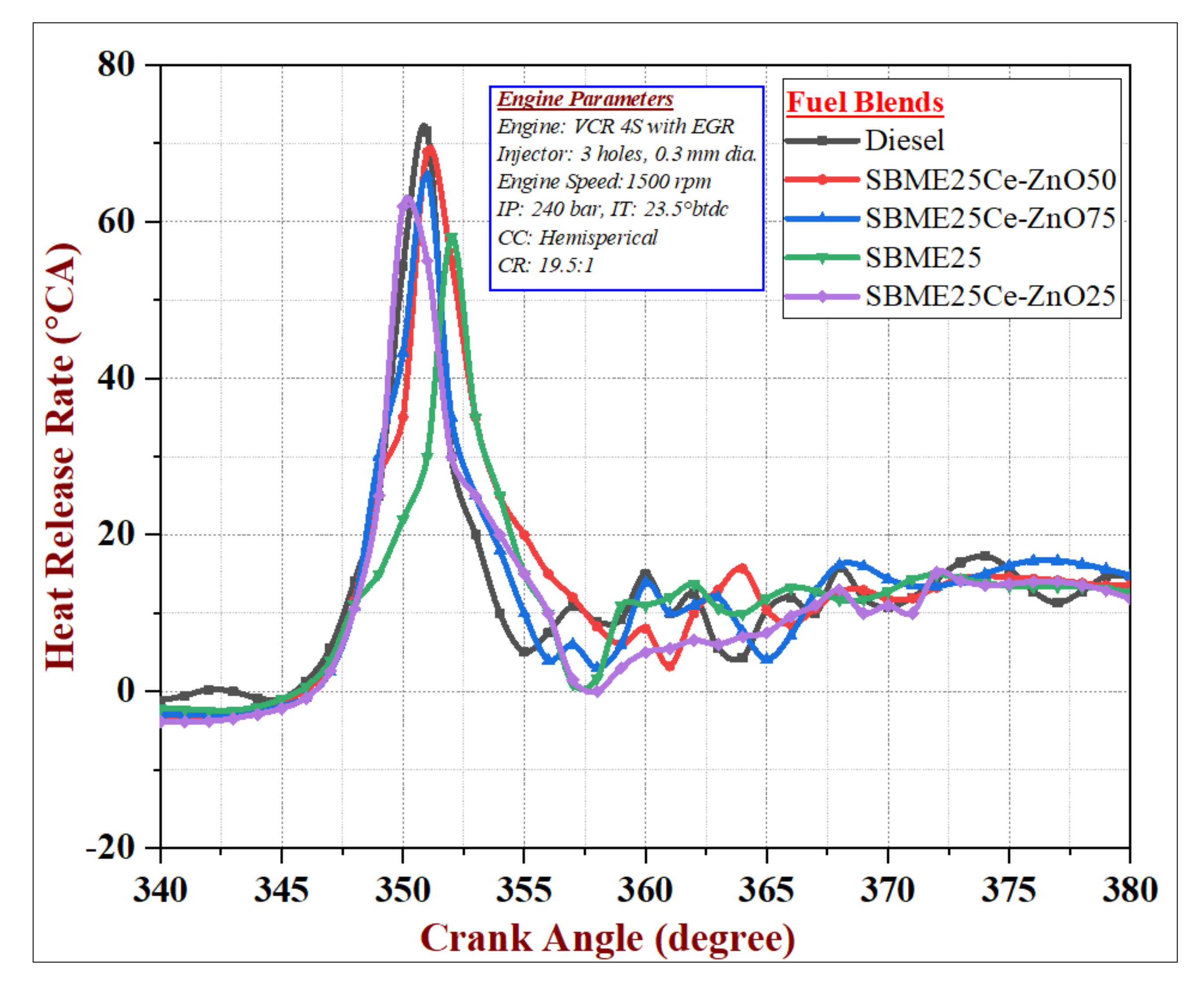

| Fatty Acid | Carbon Chain | Composition (wt. %) |
|---|---|---|
| Palmitic acid (C16H32O2) | C 16:0 | 11.24 |
| Stearic acid (C18H36O2) | C 18:0 | 4.15 |
| Oleic acid (C18H34O2) | C 18:1 | 23.69 |
| Linoleic acid (C18H32O2) | C 18:2 | 51.66 |
| Linolenic acid (C18H30O2) | C 18:3 | 6.89 |
| Parameter | Specification |
|---|---|
| Number of strokes | Four |
| Fuel type | Diesel |
| Cylinder | Single cylinder, water cooled |
| Rated power (kW) | 3.5 kW at 1500 rpm |
| Cylinder diameter (mm) × Stroke length (mm) | 87.5 mm × 110 mm |
| CR | 19.5 |
| Injection Pressure | 220 bar |
| Injection timing | 23.5 °BTDC |
| Fuel tank | 15 L with glass fuel metering column |
| Piezo sensor | Range 5000 psi, with low noise cable |
| Temperature sensor | RTD, PT100 and thermocouple type K |
| Rotameter | Eureka, Engine cooling 40–400 LPH; Calorimeter 25–250 LPH |
| Temperature sensor | Radix, Type RTD, PT100 and Thermocouple, Type K |
| Load sensor | Load cell, strain gauge type, range: 0–50 kg |
| Dynamometer | Type eddy current, water cooled with loading unit |
| Crank angle sensor | Kubler Germany, Resolution 1 Deg, Speed 5500 RPM with top dead center (TDC) pulse |
| Parameters | Accuracy (±) | Uncertainty (%) |
|---|---|---|
| BP (kW) | - | ±0.5 |
| BTE (%) | - | ±0.3 |
| BSFC (%) | - | ±0.3 |
| HRR (J/°CA) | - | ±0.5 |
| CO emission (%) | ±0.01% | ±0.3 |
| NOx emission (ppm) | ±10 ppm | ±0.7 |
| HC emission (ppm) | ±10 ppm | ±0.4 |
| Exhaust gas temperature (°C) | ±1 | ±0.4 |
| Smoke meter (HSU) | ±1 | ±0.5 |
| Properties | Unit | ASTM Test Standards | Diesel | SBME25 | SBME25Ce-ZnO25 | SBME25Ce-ZnO50 | SBME25Ce-ZnO75 |
|---|---|---|---|---|---|---|---|
| Density at 15 °C | kg/m3 | D4052 | 810 | 845.66 | 840.2 | 844.6 | 845.8 |
| Calorific value | MJ/kg | D4868 | 45 | 41.684 | 43.10 | 44.35 | 44.15 |
| Kinematic Viscosity at 40 °C | mm2/s | D445 | 2.12 | 3.56 | 3.4 | 3.5 | 3.6 |
| Cetane number | - | D613 | 51 | 48.66 | 51.6 | 52.8 | 52.9 |
| Flash point | °C | D93 | 55 | 65.71 | 60.5 | 58.2 | 59 |
| Pour point | °C | D97 | −4 | −6 | −5.1 | −5.8 | −5.8 |
© 2020 by the authors. Licensee MDPI, Basel, Switzerland. This article is an open access article distributed under the terms and conditions of the Creative Commons Attribution (CC BY) license (http://creativecommons.org/licenses/by/4.0/).
Share and Cite
Hussain, F.; Soudagar, M.E.M.; Afzal, A.; Mujtaba, M.A.; Fattah, I.M.R.; Naik, B.; Mulla, M.H.; Badruddin, I.A.; Khan, T.M.Y.; Raju, V.D.; et al. Enhancement in Combustion, Performance, and Emission Characteristics of a Diesel Engine Fueled with Ce-ZnO Nanoparticle Additive Added to Soybean Biodiesel Blends. Energies 2020, 13, 4578. https://doi.org/10.3390/en13174578
Hussain F, Soudagar MEM, Afzal A, Mujtaba MA, Fattah IMR, Naik B, Mulla MH, Badruddin IA, Khan TMY, Raju VD, et al. Enhancement in Combustion, Performance, and Emission Characteristics of a Diesel Engine Fueled with Ce-ZnO Nanoparticle Additive Added to Soybean Biodiesel Blends. Energies. 2020; 13(17):4578. https://doi.org/10.3390/en13174578
Chicago/Turabian StyleHussain, Fayaz, Manzoore Elahi M. Soudagar, Asif Afzal, M.A. Mujtaba, I.M. Rizwanul Fattah, Bharat Naik, Mohammed Huzaifa Mulla, Irfan Anjum Badruddin, T. M. Yunus Khan, Vallapudi Dhana Raju, and et al. 2020. "Enhancement in Combustion, Performance, and Emission Characteristics of a Diesel Engine Fueled with Ce-ZnO Nanoparticle Additive Added to Soybean Biodiesel Blends" Energies 13, no. 17: 4578. https://doi.org/10.3390/en13174578
APA StyleHussain, F., Soudagar, M. E. M., Afzal, A., Mujtaba, M. A., Fattah, I. M. R., Naik, B., Mulla, M. H., Badruddin, I. A., Khan, T. M. Y., Raju, V. D., Gavhane, R. S., & Rahman, S. M. A. (2020). Enhancement in Combustion, Performance, and Emission Characteristics of a Diesel Engine Fueled with Ce-ZnO Nanoparticle Additive Added to Soybean Biodiesel Blends. Energies, 13(17), 4578. https://doi.org/10.3390/en13174578










